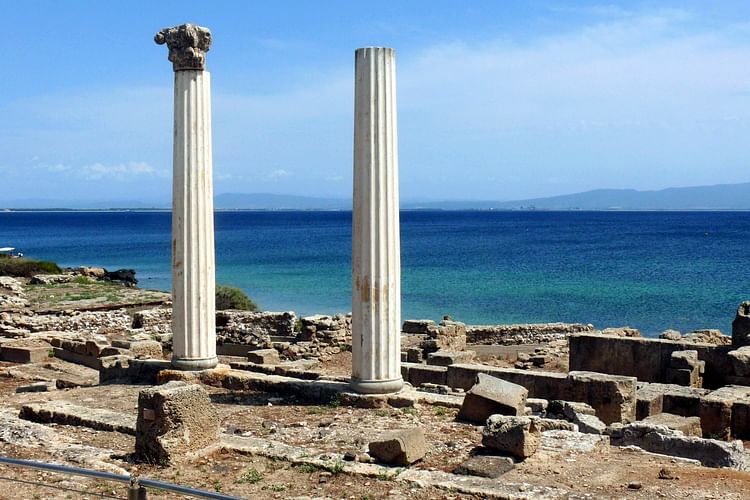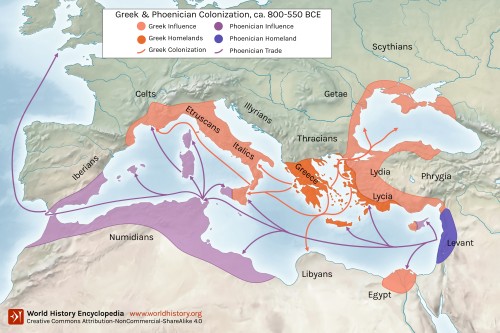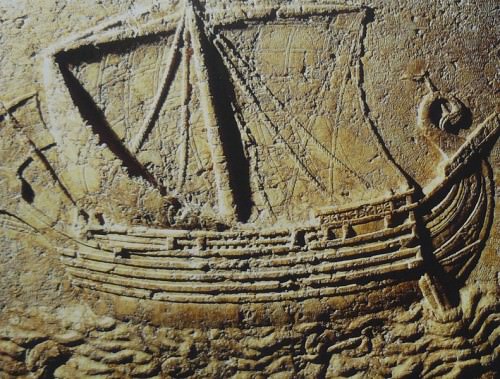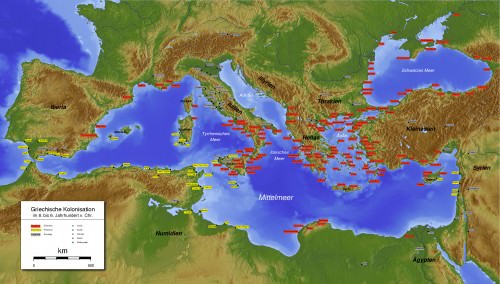Phoenician Colonization › The Phoenicians - Master Mariners » Ancient origins
Articles and Definitions › Contents
- Phoenician Colonization › Ancient History
- The Phoenicians - Master Mariners › Antique Origins
Ancient civilizations › Historical and archaeological sites
Phoenician Colonization › Ancient History
Definition and Origins

The prosperity of Phoenician cities such as Tyre, Sidon, and Byblos was based on trade, and it was the search for new commodities and new markets which resulted in the Phoenicians branching out from the narrow coastal strip of the Levantand colonizing territories throughout the ancient Mediterranean from the 10th century BCE. Some of these colonies, like Leptis Magna, Cadiz, and Palermo, became important cities in their own right, and none more so than Carthage on the north coast of Africa, which would eventually outshine its mother city of Tyre and create an empire of its own.
FROM TRADING POSTS TO COLONIES
The Phoenicians were great traders and great navigators, and this combination of skills almost inevitably resulted in them establishing colonies wherever they went. The major Phoenician trade routes were by sea to the Greek islands, across southern Europe, down the Atlantic coast of Africa, and up to ancient Britain. In addition, Arabia and India were reached via the Red Sea and vast areas of Western Asia were connected to the homeland via land routes where goods were transported by caravan.
Trade and the search for valuable commodities (for exchange, for tribute to Assyria, and also for use in the thriving Phoenician manufacturing industry) necessitated the establishment of permanent trading posts. Further, as the Phoenician ships generally (but certainly not always) sailed within sight of the coast and only in sailed in the daytime, regular way-stations were required too. These outposts, originally chosen for their safe and shallow harbours and proximity to fresh water, became more firmly established in order to control the trade in specific commodities available at that specific site. More permanent settlements could also become a valuable new market in which to sell Phoenician manufactured goods and would better protect the Phoenician's long-term business interests. In time these sites developed further, their population became more permanent and larger, their architecture more substantial, and so on, until they became full colonies and large cities in their own right.
THE PHOENICIANS WERE GREAT TRADERS & NAVIGATORS AND THIS COMBINATION OF SKILLS ALMOST INEVITABLY RESULTED IN THEM ESTABLISHING COLONIES WHEREVER THEY WENT.
The Phoenicians' colonization of the Mediterranean was perhaps motivated more by commerce than territorial expansion for its own sake, but that one led to the other seems inevitable. It is also true that the Phoenician homelands had shrunk following expansion by neighbouring powers and may also have been affected by climate change and a reduction in rainfall with a negative consequence on arable land and crop yields; a problem made worse by an ever-expanding population. Whatever the motivations, the result of this long process of colonization was a permanent Phoenician influence extending around the whole coastline of the Mediterranean.
DATING THE PROCESS
According to ancient writers, Phoenician colonization began from the 12th century BCE, but some modern historians consider this too early a date and suggest the process was contemporary with Greek colonization in the 8th century BCE.Still other scholars suggest that Phoenician contact with many sites must have been earlier than this and cite such facts as the passing on of the Phoenician alphabet to the Greeks, references in the Bible to sailing vessels of Tyre in the 10th century BCE, a reference in a 10th century source from Tyre to a colony not paying its tribute (either Utica or more likely Cyprus ), and the unanimity of ancient writers that Phoenician colonization of the Mediterranean occurred before the Greeks. It is also true that the first primitive trading posts are unlikely to have left much in the archaeological record so that scholars looking for physical evidence of colonization prior to the 8th century BCE are severely challenged to find it.

Greek and Phoenician Colonization
A compromise has, therefore, been achieved amongst scholars which posits a period of 'pre-colonial' trade centres established between the 12th to 8th centuries BCE, followed by the establishment of colonies proper between the 8th and 6th centuries BCE. In this period then, lasting over 500 years, the Phoenicians controlled a network of stopping points which established them as one of the greatest trading powers in the ancient world. Between these colonies, Phoenicia itself, and the great civilizations of the period goods were shipped and exchanged such as textiles, glass, papyrus, precious metals, wood, wool, pottery, foodstuffs, spices, and slaves.
CYPRUS & THE ISLANDS
The geographical proximity of Cyprus probably meant it was one of the first places to be colonized by the Phoenicians, perhaps as early as the 11th century BCE. Resources on the island which motivated Phoenician expansion included timber and copper. The most important city was Kition but others included Golgoi, Idalion, Tamassos, Marion, and Lapethos. Other islands in the Aegean which were colonized include Rhodes (Camiros and Ialysos), Crete (Itanos), Kythera, Melos, Thasos, and Thera.
NORTH AFRICA
Phoenicia had always had strong trade links with Egypt and trading posts were probably established there as early as anywhere else. Further along the northern coast of Africa with its fertile soil and access to interior trade goods such as ivory, the ancient sources state that Utica was established in c. 1101 BCE by Sidon. Carthage, according to the same authors, was founded in 814 BCE by Tyre. Other colonies were Auza (mentioned in texts as founded by Tyre but of unknown location), Leptis Magna, Hippo, Hadrumetum, and Lixus. When Carthage prospered and grew into a large city in its own right, it started to found colonies too, and this second wave has caused some confusion amongst historians (ancient and modern) regarding dates and who exactly founded what.

Phoenician Ship
ITALY
Sicily was colonized by the Phoenicians, although they withdrew to the western part of the island when challenged by the Greeks. Cities such as Motya, Panormo (modern Palermo), and Solunto were founded from the 8th century BCE. At the same time, colonies were established on the strategically important islands of Lampedusa, Malta, and Pantelleria. Again, just how much a role Carthage played in this process is debated amongst historians. Further west, Sardinia (rich in cereals) was colonized earlier, probably in the 9th century BCE with its important cities being Nora, Caralis (Cagliari), Bythia, Sulcis, Carloforte, and Tharros.
SPAIN
In antiquity, Spain was a rich source of silver which the Phoenicians were able to trade from indigenous peoples for relatively low-value goods such as glass, oil, and pottery. Ancient sources state that Gades (Cadiz) was established in c. 1110 BCE but the evidence is scant for such an early date and the subject controversial. Nevertheless, Tarshish (Tartessus) of Biblical fame, whose identity is unknown (and actually may not be a city name at all), was perhaps somewhere north of Gades, and likely, along with that city, founded in the 10th century BCE. Other important Phoenician colonies were Malaka (modern Malaga), Sexi (Almunecar), Abdera (Adra), and Ebusus (Ibiza). The latter, long-thought to have been a Carthaginian colony, shows evidence of an earlier Phoenician settlement.

Greek & Phoenician Colonies
RELATIONSHIP WITH THE HOMELAND
The colonies established by the Phoenicians would vary in their proximity to the home territory's own culture and practices depending on their geographical location and the strength of the indigenous culture already present. North Africa became, perhaps, more 'Phoenician' than any other territory. Elements of the Phoenician religion were adopted, gods such as Melqartand Astarte were worshipped, in time temples, sanctuaries, and cemeteries were constructed, and religious practises and festivals were carried out just as they were in the home cities of Tyre or Sidon. One of the most consistent Phoenician features found at colonies was the Tophet, the sacred precinct built outside a city where sacrifices were carried out, including children by fire (perhaps only in exceptional circumstances).
Phoenician art was another export, physical pieces but also ideas and methods. Workshops were established at colonies which could produce the fine goods, such as goldwork and purple-dyed cloth the homelands were so famous for. Architecture too was copied from the homeland, such as the temple of Melqart at Gades whose layout and columns mirrored those of the temple at Tyre.
If religion and art came in one direction, then raw materials and tributes went in the other. Each year Carthage had to send tribute, one-tenth of its yearly profits, to the Temple of Melqart at Tyre. As the colonies prospered so they expanded their territory, an action perhaps not unrelated to their population growth. They became more militarized, built fortifications, and fought with indigenous peoples or competing regional powers. They were now cities in their own right and fighting for their place in the ancient world.
LEGACY
The Phoenician colonies eventually became either absorbed by local cultures or contemporary civilizations keen to expand themselves. For example, Cyprus was conquered by the Assyrian king Sargon II at the end of the 8th century BCE, Nebuchadnezzar besieged Tyre in the early 6th century BCE, and the Greeks became more ambitious in their own colonial expansion, forcing the Phoenicians to relinquish their influence in parts of Magna Graecia. And as we have already seen, some colonies became so successful that they founded colonies of their own, in the case of Carthage from the mid-6th century BCE, even embarking on military campaigns to forge for itself an empire and take control of former Phoenician colonies. The power and influence of Phoenicia itself fell away even further following the attack of Alexander the Great in 332 BCE but it had by then, through its ambitious and daring establishment of colonies, already significantly contributed to a much more connected Mediterranean world.
The Phoenicians - Master Mariners › Antique Origins
Ancient Civilizations
Driven by their desire for trade and the acquisition of such commodities as silver from Spain, gold from Africa, and tin from the Scilly Isles, the Phoenicians sailed far and wide, even beyond the Mediterranean's traditional safe limits of the Pillars of Hercules and into the Atlantic. They were credited with many important nautical inventions and firmly established a reputation as the greatest mariners in the ancient world. Phoenician ships were represented in the art of their neighbours, and their seamanship is praised above all other by such ancient writers as Homer and Herodotus. If any nation could claim to be the masters of the seas, it was the Phoenicians.

Phoenician Small Ship
LEAVING THE HOMELAND
The Phoenicians became sailors in the first place because of the topography of their homeland, the narrow mountainous strip of land on the coast of the Levant. Travelling between settlements, usually located on rocky peninsulas, was much easier by sea, especially when carrying such cumbersome cargo as cedar wood logs for which the Phoenicians were famed. It was thanks to the very same wood the Phoenicians were never short of the necessary raw materials to build their ships. The Phoenicians also preferred the security of small islets just off the coast, the classic example being the great city of Tyre, so that ships were the most practical means of transport.
HEMMED IN BY MOUNTAINS, WHEN THE TIME CAME, THE NATURAL DIRECTION OF PHOENICIAN EXPANSION WAS NOT INLAND BUT THE SEA.
Hemmed in by mountains, then, when the time came, perhaps from the 12th century BCE, the natural direction of Phoenician expansion was not inland but the sea. As a result of this search for new resources such as gold and tin, the Phoenicians became accomplished sailors, creating an unprecedented trade network which went from Cyprus, Rhodes, the Aegeanislands, Egypt, Sicily, Malta, Sardinia, central Italy, France, North Africa, Ibiza, Spain and beyond even the Pillars of Hercules and the bounds of the Mediterranean. In time, this network transformed into an empire of colonies so that the Phoenicians criss-crossed the seas and gained the confidence to reach such far-flung places as ancient Britain and the Atlantic coast of Africa.
PHOENICIAN SHIPS
The Phoenicians were famed in antiquity for their ship-building skills, and they were credited with inventing the keel, the battering ram on the bow, and caulking between planks. From Assyrian relief carvings at Nineveh and Khorsabad, and descriptions in texts such as the book of Ezekial in the Bible we know that the Phoenicians had three types of ship, all shallow-keeled. Warships had a convex stern and were propelled by a large single-masted square sail and two banks of oars (a bireme ), had a deck, and were fitted with a ram low on the bow.
The second ship type was for transport and trade purposes. These were similar to the first type but, with wide, big-bellied hulls, they were much heavier. They perhaps had higher sides too in order to permit the stacking of cargo on deck as well as below, and they had both a convex stern and bow. Their cargo capacity was somewhere in the region of 450 tons. A fleet might consist of up to 50 cargo vessels, and such fleets are depicted in reliefs being escorted by a number of warships.

Phoenician Ship
A third type of vessel, also for trade use, was much smaller than the other two, had a horse-head at the bow and only one bank of oars. Due to its size, this vessel was only used for coastal fishing and short trips. No Phoenician ship has been recovered intact by maritime archaeologists but judging by the pictorial evidence the ships would have been difficult to handle.It is also worth noting that the more oarsmen a ship had then the less room there was for cargo. Greater manoeuvrability was, therefore, achieved by adjusting the sail when necessary and the use of a double sailing oar.
Ancient ships were far from easy to handle but in antiquity the Phoenicians were widely known as the best sailors around.Herodotus describes one episode during the build up to the second Persian invasion of Greece in 480 BCE led by Xerxes.The Persian king wanted to put his multi-national fleet through their paces and so organized a sailing race, which the sailors from Sidon won. Herodotus also mentions that Xerxes always made sure to travel on a Phoenician ship whenever he had to go anywhere by sea.
NAVIGATION
The Phoenicians did not have the compass or any other navigational instrument, and so they relied on natural features on coastlines, the stars, and dead-reckoning to guide their way and reach their destination. The most important star to them was the Pole Star of the Ursa Minor constellation and, by way of a compliment to their sea-faring skills, the Greek name for this group was actually Phoenike or 'Phoenician'. Some maps of coastal stretches are known to have existed but were unlikely to have been used during a voyage. Rather, navigation was achieved through the position of the stars, sun, landmarks, direction of the winds, and the experience of the captain of tides, currents and winds on the particular route being taken. Close to shore, Herodotus mentions the use of sounding leads to measure the sea depth, and we know that Phoenician ships had a crow's nest for greater visibility.
Historians long considered that the Phoenicians sailed only during the day-time as they had to keep close to the shoreline and within sight of landmarks; at night they, therefore, had to beach or anchor their ships and this explained the proximity of some Phoenician colonies, a day's sailing distance from each other. This simplistic view has been revised in recent years. First and foremost, the often mountainous coastline of the Mediterranean means that one can sail a great distance from land and still keep high landmarks in sight, a strategy still used by many local fishermen today. Indeed, the areas of sea where it is not possible to sight land of some sort are remarkably few in the Mediterranean, and these are places ancient mariners would have had no interest in crossing anyway. In addition, it can actually be more dangerous sailing close to a coast than out to sea where there are no rocks or unpredictable currents.

Greek and Phoenician Colonization
Neither does the traditional view take into account that the Phoenicians used astronomical observations at night. Further, many Phoenician settlements were either much closer than a day's sailing distance or much further, for example, Ibiza is 65 straight miles from Iberia. The same can be said for Sardinia and Sicily, and there is also evidence that the Phoenicians made use of even more remote smaller islands as stopping points. It seems reasonable to assume, then, that Phoenician navigators, at least in fine weather, would have chosen the shortest direct route between two points and not necessarily hugged the coast or stopped each night as much as once thought. The non-stop voyages described in both Hesiod and Homer would seem to deserve more credit as to their accuracy. It is true that in foggy or rainy weather landmarks and stars become useless but that is probably why the Phoenicians restricted their sailing season to the period between late spring and early autumn, when the Mediterranean climate is remarkably stable.
SEA ROUTES
Both Herodotus and Thucydides agree that the average speed of an ancient vessel was around 6 miles per hour, and therefore, taking into account stops for bad weather, rest etc., it would have taken, for example, 15 days to sail (and sometimes row) from Greece to Sicily. Colaios sailed from Samos to Gadir (in southern Spain), a distance of 2,000 miles, in the 7th century BCE, and that would have taken around 60 days. Long voyages, then, would frequently have required winter stop-overs and continuing in the next sailing season. Herodotus mentions this fact, even describing how the mariners were able to grow their own wheat as they waited. So, from one end of the Phoenician world to the other - Tyre to Gadir (over 1,600 miles) - might have taken 90 days or a full sailing season; the ship would have unloaded and re-loaded cargo and made the journey back the next year.

Phoenician Trade Network
The actual routes taken by the Phoenicians are much debated, but if we assume the currents of the Mediterranean have not changed since antiquity, then it seems likely that ancient mariners took advantage of the long-distance currents used by sailors today. The route west, then, would probably have been via Cyprus, the coast of Anatolia, Rhodes, Malta, Sicily, Sardinia, Ibiza, and along the coast of southern Spain to silver-rich Gadir. The homeward journey would have benefitted from the current which sweeps back right through the centre of the Mediterranean. This would give two possible routes: to Ibiza and then Sardinia, or to Carthage on the North African coast and then to either Sardinia or direct to Malta, and then Phoenicia. It is no surprise that at each of these vital strategic stopping points the Phoenicians created colonies which, in effect, cut out, at least for a few centuries, competing trading cultures such as the Greeks.
FAMOUS VOYAGES
The Phoenicians were not limited to the Mediterranean and the Atlantic, they also sailed down the Red Sea and possibly the Indian Ocean too. The book of I Kings in the Bible describes a Phoenician expedition during the 10th century BCE to a new land called Ophir in order to acquire gold, silver, ivory, and gems. The location of Ophir is not known but is variously considered to be in the Sudan, Somalia, Yemen, or even an island in the Indian Ocean. The ships of this fleet were built at Eziongeber on the Red Sea coast and funded by King Solomon. The great distance covered is suggested by the description that the expedition was repeated only every three years.
The ancient historian Diodorus claimed that the Phoenicians reached the Atlantic islands of Madeira, the Canary Islands, and the Azores. There is, though, no archaeological evidence of direct Phoenician contact, only the discovery in 1749 CE of eight Carthaginian coins dating to the 3rd century BCE. Just how they got there can only be speculated upon.
LICENSE:
Article based on information obtained from these sources:with permission from the Website Ancient History Encyclopedia
Content is available under License Creative Commons: Attribution-NonCommercial-ShareAlike 3.0 Unported. CC-BY-NC-SA License